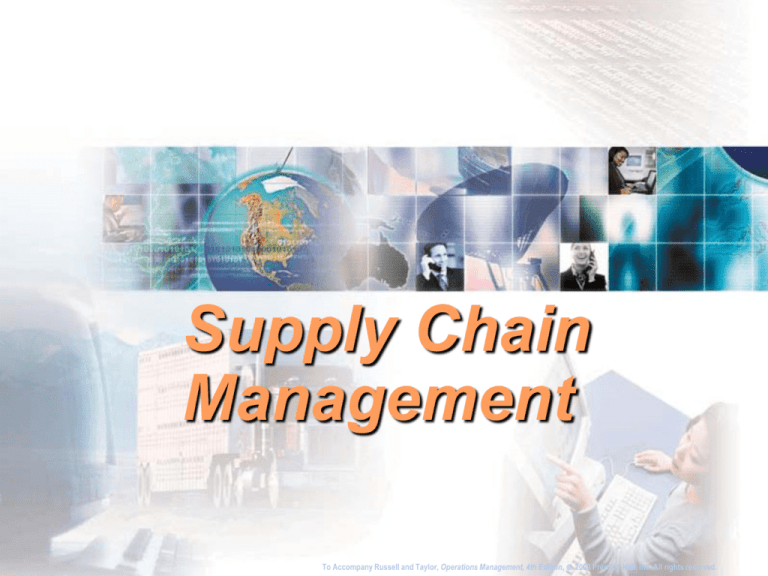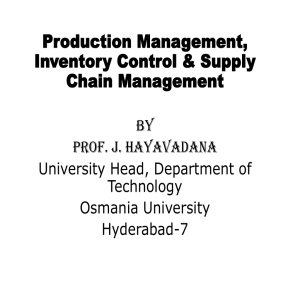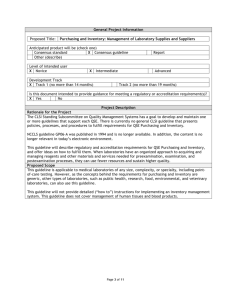
Supply Chain
Management
To Accompany Russell and Taylor, Operations Management, 4th Edition, 2003 Prentice-Hall, Inc. All rights reserved.
Supply Chain (Definition of)
The sequence of organizations- their facilities, functions,
processes and activities- that are involved in producing
and delivering a product or service
Sometimes referred to as value chain
The Supply Chain
Suppliers
Producers
Distributors
Customers
Materials,
parts, subassemblies,
and
services
Finished
goods, end
products
and services
Package
and delivery
Total
satisfaction
with quality,
price,
delivery, and
service
Inventory
Products
and
Services
Inventory
Products
and
Services
Products
and
Services
Inventory
Downstream SC members
The Supply Chain
Information
Suppliers
Producers
Distributors
Customers
Materials,
parts, subassemblies,
and
services
Finished
goods, end
products
and services
Package
and delivery
Total
satisfaction
with quality,
price,
delivery, and
service
Inventory
Products
and
Services
Inventory
Products
and
Services
Inventory
Products
and
Services
The Supply Chain
Information
Suppliers
Producers
Distributors
Customers
Materials,
parts, subassemblies,
and
services
Finished
goods, end
products
and services
Package
and delivery
Total
satisfaction
with quality,
price,
delivery, and
service
Inventory
Products
and
Services
Products
and
Services
Inventory
Inventory
Cash
Products
and
Services
Typical Supply Chain for a
Manufacturer
Supplier
Supplier
Supplier
}
Storage
Mfg.
Storage
Dist.
Retailer
Customer
Typical Supply Chain for a Service
Supplier
Supplier
}
Storage
Service
Customer
Supply Chain Management
A total system approach to managing the entire flow of
information, materials, and services from raw-material
suppliers through factories and warehouses to the end
user (planning, organizing, directing and controlling flows
of materials)
Encompasses all activities associated with the flow and
transformation of goods and services from raw materials
to the end user, the customer
Goals of Supply Chain Management
(1 of 2)
Synchronization of activities required to achieve
maximum competitive benefits
Coordination, cooperation, and communication and
timing among SC members
Ensuring rapid flow of information among members
Goals of Supply Chain Management
(2 of 2)
Linking the market, distribution channels, processes and
suppliers so that market demand is met as efficiently as
possible across the chain
Matching supply and demand at each stage of the chain
Ultimate goal: Achieving customer satisfaction
To Accompany Russell and Taylor, Operations Management, 4th Edition, 2003 Prentice-Hall, Inc. All rights reserved.
Facilities Involved in SCM
Warehouses
Factories
Processing centers
Distribution centers
Retail outlets
Offices
Strategic or Operational
• Two types of decisions in supply chain management
– Strategic – design and policy
– Operational – day-today activities
Typical Supply Chain Activities
Production
Distribution
Purchasing Receiving Storage Operations Storage
Major decision areas:
•Location
•Production
•Inventory
•Distribution
To Accompany Russell and Taylor, Operations Management, 4th Edition, 2003 Prentice-Hall, Inc. All rights reserved.
Functions and Activities Involved in SCM
Forecasting
Scheduling
Purchasing
Inventory management
Information management
Quality assurance
Production and delivery
Logistics
Customer service
Elements of Supply Chain
Management
Element
Typical Issues
Customers
Determining what customers want
Forecasting
Predicting quantity and timing of demand
Design
Incorporating customer wants, mfg., and time
Processing
Controlling quality, scheduling work
Inventory
Meeting demand while managing inventory costs
Purchasing
Evaluating suppliers and supporting operations
Suppliers
Monitoring supplier quality, delivery, and relations
Location
Determining location of facilities
Logistics
Deciding how to best move and store materials
Processes Involved in SCM
Acquiring customer orders
Procuring materials and components from
suppliers
Producing or manufacturing products
Filling customer orders
Supply-Chain Costs as a Percent of Sales
Industry
•
•
•
•
•
•
•
All industry
Automobile
Food
Lumber
Paper
Petroleum
Transportation
Percent of Sales
•
•
•
•
•
•
•
52%
67%
60%
61%
55%
79%
62%
Factors That Contribute to the Increased
Need for Effective Supply Chain
Management:
improve operations
increased levels of outsourcing
increasing transportation costs
competitive pressures
increasing globalization
increasing importance of e-commerce
increasing complexity of supply chains
increasing pressure to decrease inventories
Benefits of Supply Chain Management
Lower inventories
Lower costs
Higher productivity
Greater agility
Shorter lead times
Higher profits
Greater customer loyalty
Integration of seperate organizations into a cohesive
operating system
Actual Benefits Gained by Supply Chain
Management
Organization
Benefit
Campbell Soup
Doubled inventory turnover rate
Hewlett-Packard
Cut supply costs 75%
Sport Obermeyer
Doubled profits and increased sales 60%
National Bicycle
Increased market share from 5% to 29%
Wal-Mart
Largest and most profitable retailer in the
world
Effective Supply Chain
• Requires linking the market, distribution channels
processes, and suppliers
Requirements of a Successful Supply Chain
Trust among trading partners
Effective communications
Supply chain should enable members to 1) share
forecasts, 2) determine the status of orders in real time,
3) access inventory data of partners
Supply chain visibility
Event-management capability
The ability to detect and respond to unplanned events
Measuring SC Performance: Performance metrics
Measuring SC Performance: Inventory
Turnover
•
One of the most commonly used measures is “Inventory
Turnover”
Cost of goods sold
Inventory turnover
Average aggregate inventory value
Measuring SC Performance:
SCOR Metrics
Perspective
Metrics
Reliability
On-time delivery
Order fulfillment lead time
Fill rate (fraction of demand met from stock)
Perfect order fulfillment
Flexibility
Supply chain response time
Upside production flexibility
Expenses
Supply chain management costs
Warranty cost as a percent of revenue
Value added per employee
Assets/utilization
Total inventory days of supply
Cash-to-cash cycle time
Net asset turns
Supply Chain Uncertainty
Forecasting, lead times, batch ordering, price
fluctuations, and inflated orders contribute to
variability
Inventory is a form of insurance
Distorted information is one of the main causes of
uncertainty
Bullwhip Effect
Demand
Initial
Supplier
Final Customer
Inventory oscillations become progressively
larger moving backward through the supply chain
Inventories in a SC: Bullwhip Effect
The magnification of variability in orders in the supply-chain
Retailer’s Orders
Time
A lot of retailers
each with little
variability in their
orders….
Wholesaler’s
Orders
Manufacturer’s
Orders
Time
…can lead to greater
variability for a fewer
number of
wholesalers, and…
Time
…can lead to even
greater variability for
a single
manufacturer.
Inventories in a SC: Bullwhip Effect
Amount of
= inventory
Tier 2
Suppliers
Tier 1
Suppliers
Producer
Distributor
Retailer
Final
Customer
Role of Information in the Supply Chain
(1 of 2)
Centralized coordination of information flows
Integration of transportation, distribution, ordering, and
production
Direct access to domestic and global transportation and
distribution channels
Locating and tracking the movement of every item in the
supply chain
To Accompany Russell and Taylor, Operations Management, 4th Edition, 2003 Prentice-Hall, Inc. All rights reserved.
Role of Information in the Supply Chain
(2 of 2)
Data interchange
Data acquisition at the point of origin and point of sale
Intercompany and intracompany information access
Instantaneous updating of inventory levels
To Accompany Russell and Taylor, Operations Management, 4th Edition, 2003 Prentice-Hall, Inc. All rights reserved.
Some IT Applications for SCM (1 of 3)
Electronic Business (replacement of physical processes
with electronic ones)
Electronic Data Interchange (a computer-to-computer
exchange of business documents in a standard format)
Bar Coding (computer readable codes attached to items
flowing through the SC). Generates point-of-sale data
which is useful for determining sales trends, ordering,
production scheduling, and delivery plans
Some IT Applications for SCM (2 of 3)
RFID Technology
•Used to track goods in supply chain
•RFID tags attached to objects
•Similar to bar codes but uses radio frequency to transmit
product information to receiver
•RFID eliminates need for manual counting and bar code
scanning
To Accompany Russell and Taylor, Operations Management, 4th Edition, 2003 Prentice-Hall, Inc. All rights reserved.
Some IT Applications for SCM (3 of 3)
Internet (provides instant access to organizations,
individuals and information sources; fundamentaly
changes the way organizations do business; add speed
and accessibility to the SC)
Intranets (internet-like networks that operate within a
single organization)
Extranets (intranets that can be connected to the global
internet & that include a company’s suppliers and
customers; they allow limited access)
To Accompany Russell and Taylor, Operations Management, 4th Edition, 2003 Prentice-Hall, Inc. All rights reserved.
The Internet
Instant global access to organizations,
individuals, and information sources
Fundamentally changes the way organizations
do business
Removed geographic
barriers
Adds speed and accessibility
to the supply chain
To Accompany Russell and Taylor, Operations Management, 4th Edition, 2003 Prentice-Hall, Inc. All rights reserved.
Build-to-Order Cars over the
Internet
To Accompany Russell and Taylor, Operations Management, 4th Edition, 2003 Prentice-Hall, Inc. All rights reserved.
E-Business
• E-Business: the use of electronic technology to
facilitate business transactions
• Applications include:
– Internet buying and selling
– E-mail
– Order and shipment tracking
– Electronic data interchange
To Accompany Russell and Taylor, Operations Management, 4th Edition, 2003 Prentice-Hall, Inc. All rights reserved.
Advantages of E-Business (1 of 2)
Global presence and increased visibility
Global access to markets and customers
Improved competitiveness, quality and service
Greater choices and more information for customers
Collection and analysis of customer data and
preferences
Shortened supply chain response times
Advantages of E-Business (2 of 2)
Shorten transaction times for ordering and
delivery
Cost and price reductions
Virtual companies with lower prices
Leveling the playing field for small companies
Reducing or eliminating intermediaries
Improved service
To Accompany Russell and Taylor, Operations Management, 4th Edition, 2003 Prentice-Hall, Inc. All rights reserved.
Disadvantages of E-Business
• Customer expectations
– Order quickly -> fast delivery
• Order fulfillment
– Order rate often exceeds ability to fulfill it
• Inventory holding
– Outsourcing loss of control
– Internal holding costs
IT Issues
Increased benefits and sophistication come with
increased costs
Efficient web sites do not necessarily mean the rest
of the supply chain will be as efficient
Security problems are very real
Partnership and trust are important elements that
may be new to business relationships
Purchasing
• Purchasing is responsible for obtaining the
materials, parts, and supplies and services
needed to produce a product or provide a
service.
• Purchasing cycle: Series of steps that begin with
a request for purchase and end with notification
of shipment received in satisfactory condition.
Duties of Purchasing
• Identifying sources of supply
• Negotiating contracts
• Maintaining a database of suppliers
• Obtaining goods and services
• Managing supplies
Purchasing Interfaces
Legal
Operations
Accounting
Purchasing
Data
processing
Design
Receiving
Suppliers
Purchasing Cycle
Legal
1. Requisition received
Operations
Accounting
2. Supplier selected
3. Order is placed
Purchasing
Data
processing
4. Orders are monitored
5. Orders are received
Design
Receiving
Suppliers
Centralized vs Decentralized
Purchasing
• Centralized purchasing
– Purchasing is handled by one special
department
• Decentralized purchasing
–Individual departments or separate
locations handle their own purchasing
requirements
Suppliers
• Choosing suppliers
• Evaluating sources of supply
• Supplier audits
• Supplier certification
• Supplier relationships
• Supplier partnerships
To Accompany Russell and Taylor, Operations Management, 4th Edition, 2003 Prentice-Hall, Inc. All rights reserved.
Sourcing
Sourcing is the selection of suppliers
Relationship between customers and suppliers focuses
on collaboration and cooperation
Outsourcing has become a long-term strategic decision
Organizations focus on core competencies
Single-sourcing is
increasingly a part
of supplier relations
Suppliers
Purchased materials account for about half of
manufacturing costs
Materials, parts, and service must be delivered on time, of
high quality, and low cost
Suppliers should be integrated into their customers’
supply chains
Partnerships should be established
On-demand delivery (JIT) is a frequent requirement
Vendor Analysis
Evaluating the sources of supply in terms of:
• Price
• Quality
• Flexibility
• Location
• Product or service changes
• Reputation and financial stability
• Lead times and on-time delivery
• Inventory policy
• Services (such as technical support) provided
Supplier as a Partner
Aspect
Adversary
Partner
Number of suppliers
Many
One or a few
Length of relationship
May be brief
Long-term
Low price
Major consideration
Moderately important
Reliability
May not be high
High
Openness
Low
High
Quality
May be unreliable;
buyer inspects
At the source; vendor
certified
Volume of business
May be low
High
Flexibility
Relatively low
Relatively high
Location
Widely dispersed
Nearness is important
Supplier Partnerships
• Ideas from suppliers could lead to improved
competitiveness
1.Reduce cost of making the purchase
2.Reduce transportation costs
3.Reduce production costs
4.Improve product quality
5.Improve product design
6.Reduce time to market
7.Improve customer satisfaction
8.Reduce inventory costs
9.Introduce new products or services
E-Procurement
Business-to-business commerce conducted on the
Internet
Benefits include lower transaction costs, lower
prices, reduce clerical labor costs, and faster
ordering and delivery times
Currently used more for indirect goods
E-Marketplaces service industry-specific
companies and suppliers
The Wal-Mart Supply
Chain
Centralized Supply at Honda
America
Distribution System
Encompasses all of the distribution channels,
processes and functions, including warehousing and
transportation, that a product passes through on its
way to the final customer.
Distribution
The actual movement of products and materials
between locations
Handling of materials and products at receiving docks,
storing products, packaging, and shipping
Often called logistics
Driving force today
is speed
Particularly important
for Internet dot-coms
Logistics
Refers to the movement of materials and information
within a facility and to incoming and outgoing
shipments of goods and materials in a supply chain
Materials Movement
Work center
Work center
Work
center
Storage
Work
center
Storage
RECEIVING
Storage
Shipping
Figure 7.5 Order Fulfillment
at Amazon.com
To Accompany Russell and Taylor, Operations Management, 4th Edition, 2003 Prentice-Hall, Inc. All rights reserved.
Third-Party Logistics
The term used to describe the outsourcing of logistics
management.
Reverse Logistics
• Reverse logistics – the backward flow of goods
returned to the supply chain
• Processing returned goods
– Sorting, examining/testing, restocking, repairing
– Reconditioning, recycling, disposing
• Gatekeeping – screening goods to prevent incorrect
acceptance of goods
• Avoidance – finding ways to minimize the number of
items that are returned
Distribution Centers
and Warehousing
Trend is for more frequent orders in smaller
quantities
Flow-through facilities and automated material
handling
Final assembly and product configuration may be
done at the DC
Warehouse Management Systems
Highly automated systems
Controls item putaway, picking, packing, and shipping
Cross-docking: Goods arriving at a warehouse from a
supplier are unloaded from the supplier’s truck and
loaded onto outbound trucks
Avoids warehouse storage
A WMS
Vendor-Managed Inventory
Stocking information is accessed using EDI
A first step towards supply chain collaboration
Increased speed, reduced errors, and improved
service
Transportation
The movement of a product from one location to another
as it makes its way to the end-use customer
Important element, often overlooked
Common methods are railroads, trucking, water, air,
intermodal, package carriers, and pipelines
Linking the Supply Chain with SAP
SC Design System: CPFR
Collaborative Planning, Forecasting, and
Replenishment
A system
based on the notion that there should be
cooperation among supply chain partners in
planning, coordination of activities and information
sharing, which in turn requires partners to agree
on common goals (goal sharing)
CPFR Process
• Internet-based exchange of data and information
• Significant decrease in inventory levels and more
efficient logistics
• Companies focus on core competencies
CPFR Results
• Nabisco and Wegmans
– 50% increase in category sales
• Wal-mart and Sara Lee
– 14% reduction in store-level inventory
– 32% increase in sales
• Kimberly-Clark and Kmart
– Increased category sales that exceeded market
growth
Global Supply Chain Problems
National and regional differences
Customs, business practices, and regulations
Foreign markets are
not homogeneous
Quality can be a
major issue
Some Issues in Global Supply Chains
– Language
– Culture
– Currency fluctuations
– Political
– Transportation costs
– Local capabilities
– Finance and economics
– Environmental
Infrastructure Obstacles to Global
Trade
Some emerging markets lack suitable distribution
systems, i.e. roads, rail systems
Existing roads and
ports may be inadequate
Market instability,
political instability
Vertical integration is a common solution
Creating an Effective Supply Chain
1. Develop strategic objectives and tactics
2. Integrate and coordinate activities in the internal
supply chain
3. Coordinate activities with suppliers & with customers
4. Coordinate planning and execution across the supply
chain
5. Form strategic partnerships
Supply Chain Performance Drivers
1. Quality
2. Cost
3. Flexibility
4. Velocity
5. Customer service
Velocity
• Inventory velocity
–The rate at which inventory(material) goes
through the supply chain
• Information velocity
–The rate at which information is communicated
in a supply chain
Challenges to Optimizing SCs
Barriers to integration of organizations
Getting top management on board
Small businesses
Variability and uncertainty
Long lead times
Dealing with trade-offs
Trade-offs in SCM
1. Lot-size-inventory
2. Inventory-transportation costs
– Cross-docking
3. Lead time-transportation costs
4. Product variety-inventory
– Delayed differentiation
5. Cost-customer service
– Disintermediation
Techniques to Increase SC Efficiency
• Delayed differentiation
–Production of standard components and
subassemblies, which are held until late in the
process to add differentiating features
• Disintermediation
–Reducing one or more steps in a supply chain by
cutting out one or more intermediaries
+ Cross Docking
+ Drop Shipping
Potential Solutions to SC Problems
Problem
Potential
Improvement
Benefits
Possible
Drawbacks
Large
inventories
Smaller, more frequent Reduced holding
deliveries
costs
Traffic congestion
Increased costs
Long lead
times
Delayed differentiation
Disintermediation
Quick response
May not be feasible
May need absorb
functions
Large number
of parts
Modular
Fewer parts
Simpler ordering
Less variety
Cost
Quality
Outsourcing
Reduced cost,
higher quality
Loss of control
Variability
Shorter lead times,
better forecasts
Able to match
supply and
demand
Less variety
Critical Issues in SCM
• Increased strategic importance
• Emphasis on cost, quality,agility and customer
service
• Technology management
• Increased conversion to lean production
• Just-in-time deliveries
• Few suppliers and vendor integration
• Increased outsourcing
• Globalization






